|

|

|

|

|

|
|
Thursday,
June 1, 2006
 United
93
- The
movie United 93
has
been showing at the local theater, but ended its run today. I
finally went to see it yesterday. It was, in a word,
excellent. There are no stars in the film, which heightens the
realism. Also, the choppy chatter of dialog rings real.
There is an unfolding of the story without any particular character
development. We really are given a "you are there"
perspective, except that the movie does cut back and forth between the
flight, some military air command post, the FAA post and various
airport traffic controller facilities. There is no action shown
on the other hijacked aircraft, although it is the take-over of
American 11 that triggers the official involvement. Well worth
remembering these events, especially if one only knew parts of the
full story. Watching this movie prompted a couple of thoughts
that I think are relevant to this topic. United
93
- The
movie United 93
has
been showing at the local theater, but ended its run today. I
finally went to see it yesterday. It was, in a word,
excellent. There are no stars in the film, which heightens the
realism. Also, the choppy chatter of dialog rings real.
There is an unfolding of the story without any particular character
development. We really are given a "you are there"
perspective, except that the movie does cut back and forth between the
flight, some military air command post, the FAA post and various
airport traffic controller facilities. There is no action shown
on the other hijacked aircraft, although it is the take-over of
American 11 that triggers the official involvement. Well worth
remembering these events, especially if one only knew parts of the
full story. Watching this movie prompted a couple of thoughts
that I think are relevant to this topic.
 Paradigm
shifts can happen quickly.
What struck me at the time, and still
does, is how fast a paradigm shift can occur. In this case,
the shift was from tolerance of hijackers to intolerance. As
voiced by a couple of passengers in the film, we have a history of
dealing with hijackers that generally want to make a statement, or
try to extort particular concessions from some government.
They aren't particularly interested in killing the passengers, and
themselves, in the exercise, although they may threaten to do so.
But, after finding out about the planes crashed into the World Trade
Center, these passengers decided to act to thwart these terrorists.
A few held out for doing nothing (at least, as portrayed in the
film) despite the information that was coming in from phone
conversations by various passengers. [Another interesting
aspect is the fact that such conversations could take place.]
The bottom line is that this paradigm - tolerating hijackers - is
over. Although a great deal has been made about beefing up
security, and the attendant waste of tons of money, the events of
9/11 cannot occur again - four, or five, men armed with box cutters
will never be able to take over another airplane.
Paradigm
shifts can happen quickly.
What struck me at the time, and still
does, is how fast a paradigm shift can occur. In this case,
the shift was from tolerance of hijackers to intolerance. As
voiced by a couple of passengers in the film, we have a history of
dealing with hijackers that generally want to make a statement, or
try to extort particular concessions from some government.
They aren't particularly interested in killing the passengers, and
themselves, in the exercise, although they may threaten to do so.
But, after finding out about the planes crashed into the World Trade
Center, these passengers decided to act to thwart these terrorists.
A few held out for doing nothing (at least, as portrayed in the
film) despite the information that was coming in from phone
conversations by various passengers. [Another interesting
aspect is the fact that such conversations could take place.]
The bottom line is that this paradigm - tolerating hijackers - is
over. Although a great deal has been made about beefing up
security, and the attendant waste of tons of money, the events of
9/11 cannot occur again - four, or five, men armed with box cutters
will never be able to take over another airplane.
 A
"what if" scenario.
We can all admire the efforts made by these passengers on that fateful
day. Yet, the object of this group of hijackers was the nation's
capitol. What if this attack had succeeded? And, what if a
significant number of representatives and senators had been
victims? Something inside tells me that our current "war on
terror" would have a lot more support from the gutless wonders
that "serve" on Capitol Hill. Sure, there would still
be questions about WMDs and the link between Saddam and
al-Qaeda. But, I bet there would be less hand wringing about our
stirring up a hornet's nest, versus targeting individual hornets, as a
long-run strategy to ending this problem. A free and democratic
Iraq, as flawed as it is (and will be) still can serve as an engine of
change in that part of the world. That idea represents the kind
of vision that the first President Bush sorely lacked.
A
"what if" scenario.
We can all admire the efforts made by these passengers on that fateful
day. Yet, the object of this group of hijackers was the nation's
capitol. What if this attack had succeeded? And, what if a
significant number of representatives and senators had been
victims? Something inside tells me that our current "war on
terror" would have a lot more support from the gutless wonders
that "serve" on Capitol Hill. Sure, there would still
be questions about WMDs and the link between Saddam and
al-Qaeda. But, I bet there would be less hand wringing about our
stirring up a hornet's nest, versus targeting individual hornets, as a
long-run strategy to ending this problem. A free and democratic
Iraq, as flawed as it is (and will be) still can serve as an engine of
change in that part of the world. That idea represents the kind
of vision that the first President Bush sorely lacked.
|
|

|
|
Friday,
June 2, 2006
 Markets
do work
- This
past Wednesday, the local paper ran an editorial titled,
"Consider responsible drilling on U.S. soil," by Philip
Gold. This was a reprint from its appearance in the Christian
Science Monitor. The basic idea was that an impartial panel
could select domestic drilling sites, weighing the relevant benefits
and costs, and submit a single list to Congress for an up-or-down
vote, as is done these days with regard to military base
closures. Well, it is interesting, but it still ignores the
issue of why the government should be so involved in the first
place. But, what troubled me about Gold's editorial was that he
claimed that, when it came to oil and gas, the market just didn't work
- "According to common belief, high prices inevitably call forth both consumer conservation and increased supply...But it doesn't work that way."
Nonsense. His reasoning was shallow in the extreme, and it lead
to some rather perverse conclusions. So, I penned the following
letter to the editor: Markets
do work
- This
past Wednesday, the local paper ran an editorial titled,
"Consider responsible drilling on U.S. soil," by Philip
Gold. This was a reprint from its appearance in the Christian
Science Monitor. The basic idea was that an impartial panel
could select domestic drilling sites, weighing the relevant benefits
and costs, and submit a single list to Congress for an up-or-down
vote, as is done these days with regard to military base
closures. Well, it is interesting, but it still ignores the
issue of why the government should be so involved in the first
place. But, what troubled me about Gold's editorial was that he
claimed that, when it came to oil and gas, the market just didn't work
- "According to common belief, high prices inevitably call forth both consumer conservation and increased supply...But it doesn't work that way."
Nonsense. His reasoning was shallow in the extreme, and it lead
to some rather perverse conclusions. So, I penned the following
letter to the editor:
|
To the
editor:
Philip
Gold’s editorial contained some interesting ideas, but his
premise – that market don’t work – is dangerously
flawed.
Yes, the
demand for oil is “inelastic.” So what? That
just means that it will take people longer to fully react to
price changes, assuming that these price changes are
permanent, in real purchasing power terms. If the price
of Coke rises to $3 a can, consumers will respond right away -
buying Pepsi and other substitutes. But, there aren’t
really good substitutes for oil. When its price rises,
it takes a while to fully respond.
How will
consumers react? They’ll double up on trips, going to
the store on their way home from work. They’ll cut
back on non-work travel, making fewer trips to Phoenix per
month. They’ll go hiking up Mt. Humphreys rather than
drive to the Grand Canyon. For some, carpooling will
become more convenient. All these actions reduce our
gasoline consumption.
Over time,
we are likely to see more dramatic changes – people living
closer to work and buying more fuel efficient cars. Yes,
markets do respond. After all, many Japanese companies
profited quite well by satisfying Americans' demand for high
gas mileage cars back in the 1970s.
The illogical consequence of
Gold’s premise is his suggestion that domestic supplies be
priced “below market prices, as a stabilizer.” Ouch!
Pricing any good below the market price doesn’t stabilize
anything. It only creates a shortage, forcing consumers
to pay in other ways – standing in line, buying gas only on
certain days, or offering under the table payments to insure
they aren’t left holding the empty gas can. It is a
recipe for chaos.
Dennis Foster
Flagstaff, Arizona |
|
|

|
|
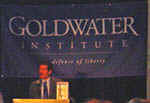 Wednesday,
June 7, 2006 Wednesday,
June 7, 2006
 Lies,
Myths & John Stossel
- Last week, the
Goldwater
Institute
sponsored a luncheon featuring ABC News
reporter/commentator
John
Stossel. He
has been on the road recently, plugging his new
book,
Myths,
Lies and Downright Stupidity. Although he has been an
unparalleled champion of free markets and economic liberty for many
years, this is only his second foray into the book market, and his
first one wasn't all that long ago. I was quite interested in
attending this lunch, and was accompanied by my wife, Cara Lynn, and
two of my students (my treat). Lies,
Myths & John Stossel
- Last week, the
Goldwater
Institute
sponsored a luncheon featuring ABC News
reporter/commentator
John
Stossel. He
has been on the road recently, plugging his new
book,
Myths,
Lies and Downright Stupidity. Although he has been an
unparalleled champion of free markets and economic liberty for many
years, this is only his second foray into the book market, and his
first one wasn't all that long ago. I was quite interested in
attending this lunch, and was accompanied by my wife, Cara Lynn, and
two of my students (my treat).
Stossel has been a favorite of mine for many years. I was first
introduced to his work when I sat through a colleague's class when
they were watching Stossel's "Is America #One?" video.
I soon ordered a copy to show in my classes, and, since then, have
added two other of his 20/20 specials: "Greed" and
"Tampering With Nature." My students really like these
videos - I think they are eager to hear from someone that makes sense
of the world around them, and cuts through all the mumbo jumbo.
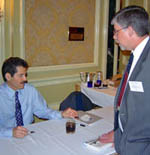 Needless to say, the presentation was excellent, and, not
surprisingly, well-received by a packed house at this event.
Stossel is, I think, taken a bit aback by a room full of
supporters. Afterwards, he signed copies of his new book.
Needless to say, the presentation was excellent, and, not
surprisingly, well-received by a packed house at this event.
Stossel is, I think, taken a bit aback by a room full of
supporters. Afterwards, he signed copies of his new book.
I am about half way through the book and it is a great read, although
depressing in the sense of how much junk goes on around us.
Stossel seems rather reserved in his speaking roles, but, in the book,
he really has taken off the kid gloves and is much more explicit about
what he thinks of people that work to limit our liberties. [But,
not as explicit as, say, Penn
& Teller.] It may just make it to my "required
reading" list for my economics students next spring (but, then,
I'd likely have to give up the excellent book, How
Capitalism Saved America).
|
|

|
|

Thursday,
June 15, 2006
 The
Woody Fire
- Late
yesterday afternoon, Flagstaff residents found themselves
suddenly under billowing plumes of smoke. It isn't all that
unusual for smoke to blow through the area, from distant fires, but
this one was close. My wife, Cara Lynn, spotted the plume from
I-17, at the airport exit, at about 4:15 p.m. As her son lives
in the same general vicinity as the smoke, she
decided to check it out. She got on I-40, westbound, and just a
couple of miles down the road took some photos, below, with her camera
phone. While the local paper has described this fire as starting
at 4:40 p.m., they are certainly off by about an hour. In the
second picture, below, she had just passed by three fire engines that
were responding to the fire. She said that, while passing by the
fire, she could feel the heat quite intensely. After getting
home, she e-mailed these three photos to Channel
3, in Phoenix, which ran them often over the next hour during
their coverage of this fire. They also posted them
up on their web site as part of a photo gallery for this fire. The
Woody Fire
- Late
yesterday afternoon, Flagstaff residents found themselves
suddenly under billowing plumes of smoke. It isn't all that
unusual for smoke to blow through the area, from distant fires, but
this one was close. My wife, Cara Lynn, spotted the plume from
I-17, at the airport exit, at about 4:15 p.m. As her son lives
in the same general vicinity as the smoke, she
decided to check it out. She got on I-40, westbound, and just a
couple of miles down the road took some photos, below, with her camera
phone. While the local paper has described this fire as starting
at 4:40 p.m., they are certainly off by about an hour. In the
second picture, below, she had just passed by three fire engines that
were responding to the fire. She said that, while passing by the
fire, she could feel the heat quite intensely. After getting
home, she e-mailed these three photos to Channel
3, in Phoenix, which ran them often over the next hour during
their coverage of this fire. They also posted them
up on their web site as part of a photo gallery for this fire.
While the fire spread fast, and the high winds were really fanning the
flames, fire crews responded quickly, and we had air tankers, as well
as helicopters loaded with water buckets, fighting the fire by 6 p.m.,
if not earlier. We dodged a bullet on this one, in part due to
the quick response of firefighters, as well as forest thinning, which
has been an ongoing effort around this area for a few years, despite
the protests of some environmental
nuts. In an additional ironic twist, the local paper
featured a front page story, yesterday morning, about police rousting
out summertime transients, who illegally set up campsites in the local
forests. Ironic because the police were just issuing warnings
and letting this activity go on for up to a week before taking
definitive action! That may change as a result of this fire, not
that it was caused by a transient, but it does highlight the risks
posed.
| Click
on any picture to see a larger image (including the panorama,
above). |
 |
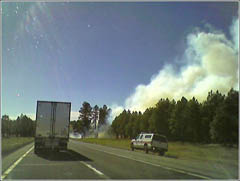 |
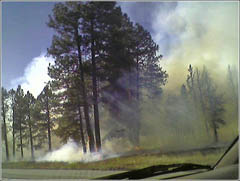
|
|
Approaching
fire, near the Flagstaff Ranch Road exit, along I-40. |
Fire starting
point, along I-40.
Photo taken just at 4:25 p.m. |
Trees
engulfed in smoke, with
flames at their base.
|
|
|

|
|
Monday,
June 26, 2006

 Local
Hiking - Last Call
- Last Friday the local forests were closed, until our monsoon
season starts and the danger
of fire abates. Luckily, I had the chance to do a couple of
outstanding Local
Hiking - Last Call
- Last Friday the local forests were closed, until our monsoon
season starts and the danger
of fire abates. Luckily, I had the chance to do a couple of
outstanding 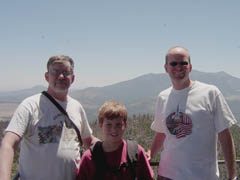 local
trails just before that happened. On Saturday, June 17, hiking
buddy Russell, and his son, Russell (yes, no end of confusion there)
climbed up to the top of 10,400 foot Kendrick
Peak, located a few miles north, and west, of the San Francisco
Peaks, which loom so prominently over Flagstaff. It was a
beautiful day, but my dog, Scout, tired out in the heat of the
afternoon. Still we covered the 9 miles, round trip, in about
six hours, including rest breaks and lunch at the top. The fire
lookout was being manned, but there wasn't anything going on at that
time. The lookout, and the small area at the peak, were swarming
with flying insects, so we didn't really stay very long. In
fact, you can see the bugs in the group picture of us (click
on any picture to see a larger image).
The panorama of the San Francisco peaks, above, was taken from the
fire lookout. Quite noticeable are the ski slopes (to the right,
along the side of Agassiz Peak) and Sunset
Crater, to the left of the peaks. local
trails just before that happened. On Saturday, June 17, hiking
buddy Russell, and his son, Russell (yes, no end of confusion there)
climbed up to the top of 10,400 foot Kendrick
Peak, located a few miles north, and west, of the San Francisco
Peaks, which loom so prominently over Flagstaff. It was a
beautiful day, but my dog, Scout, tired out in the heat of the
afternoon. Still we covered the 9 miles, round trip, in about
six hours, including rest breaks and lunch at the top. The fire
lookout was being manned, but there wasn't anything going on at that
time. The lookout, and the small area at the peak, were swarming
with flying insects, so we didn't really stay very long. In
fact, you can see the bugs in the group picture of us (click
on any picture to see a larger image).
The panorama of the San Francisco peaks, above, was taken from the
fire lookout. Quite noticeable are the ski slopes (to the right,
along the side of Agassiz Peak) and Sunset
Crater, to the left of the peaks.
 Russell and I had planned to climb Mt. Humphrey's, at 12,633 feet, the
tallest in Arizona, on Saturday, June 24. But, on Tuesday (6/20)
we got word that the forests would be closing down that week, no doubt
spurred on by the Brins Fire in Oak Creek Canyon. So, we decided
to get our hike in last Wednesday. We were on the trail by 7
a.m., and there were a few parties ahead of us. But, it was cool
and pleasant hiking all the way to the top. We covered the 9.2
miles, round trip, and 3100 feet of elevation change, in seven
hours. At the top, we could easily see the Brins Fire burning in
Oak Creek, as shown in the photo, to the left, with Agassiz in the
foreground. For once, I didn't sign the register - the box was
overstuffed with papers, and some were scattered about the area.
Too bad. You'd figure that some forest service person treks up
here on a regular basis and that they could keep this from
happening. Well, I'd think so. And, here's another
suggestion:
Russell and I had planned to climb Mt. Humphrey's, at 12,633 feet, the
tallest in Arizona, on Saturday, June 24. But, on Tuesday (6/20)
we got word that the forests would be closing down that week, no doubt
spurred on by the Brins Fire in Oak Creek Canyon. So, we decided
to get our hike in last Wednesday. We were on the trail by 7
a.m., and there were a few parties ahead of us. But, it was cool
and pleasant hiking all the way to the top. We covered the 9.2
miles, round trip, and 3100 feet of elevation change, in seven
hours. At the top, we could easily see the Brins Fire burning in
Oak Creek, as shown in the photo, to the left, with Agassiz in the
foreground. For once, I didn't sign the register - the box was
overstuffed with papers, and some were scattered about the area.
Too bad. You'd figure that some forest service person treks up
here on a regular basis and that they could keep this from
happening. Well, I'd think so. And, here's another
suggestion:
 Leave
some trails open!
I have yet to hear of a fire caused by hikers and bike riders.
Yet, we are the ones that bear the brunt of these forest
closures. And, the forest service has solicited the services of
almost 200 volunteers to keep the dirt roads and trails closed.
So, why not keep some open? Like, the Snowbowl road for
bikers? Or the Mt. Elden Fatman loop trail for hikers? We
can use the services of these volunteers to monitor activities without
really raising our risks. But, no. Instead, the forest
service decides that closing everything to everybody is the best way
to proceed. I disagree.
Leave
some trails open!
I have yet to hear of a fire caused by hikers and bike riders.
Yet, we are the ones that bear the brunt of these forest
closures. And, the forest service has solicited the services of
almost 200 volunteers to keep the dirt roads and trails closed.
So, why not keep some open? Like, the Snowbowl road for
bikers? Or the Mt. Elden Fatman loop trail for hikers? We
can use the services of these volunteers to monitor activities without
really raising our risks. But, no. Instead, the forest
service decides that closing everything to everybody is the best way
to proceed. I disagree.
Related
blogs:
 A
Break in the Action
A
Break in the Action
 Snowy
Mt. Humphreys Snowy
Mt. Humphreys
 Highest
Ranked Blogmeister in Arizona Highest
Ranked Blogmeister in Arizona
|
|

|
|
Wednesday,
June 28, 2006
 The
Union is No Prescription
- Last week, nurses at the Flagstaff Medical Center voted down
the efforts to organize a union, which were being spearheaded by a
California nurses union. Three cheers for the FMC nurses that
voted against this effort to become parasites in a system that is
already bleeding us dry. I think that the main reason for this
outcome is that most nurses recognize that the quality of their work
environment will suffer, even if they get more pay. The
Union is No Prescription
- Last week, nurses at the Flagstaff Medical Center voted down
the efforts to organize a union, which were being spearheaded by a
California nurses union. Three cheers for the FMC nurses that
voted against this effort to become parasites in a system that is
already bleeding us dry. I think that the main reason for this
outcome is that most nurses recognize that the quality of their work
environment will suffer, even if they get more pay.
The organizers had claimed that their main interest was "patient
care." What malarkey! Too bad we can't impose
truth-in-advertising to the union. The only thing the union -
any union - cares about is the wealth of its members. And, it
isn't necessarily interested in maximizing its membership, as that
would reduce wages. Given that unions have special legal
protections, not afforded to business interests, they become nothing
more than state-sanctioned extortionists. The notion that
workers should, as a matter of law, have rights to control and constrain
a business' decisions is . . . well, it's just bizarre. Property
owners get to make decisions about how to use their property.
And, in the business environment, those are stockholders. If
workers want to control a business, buy their stock. In the case
of the hospital, a non-profit institution, they could give up some of
their salary, say 25%, in order to become financial investors in the
organization, with a seat at the table.
That is not to say that businesses can just ignore workers.
Workforce morale is quite important to the success of any business,
but unionization isn't going to create that morale. Instead, it
deepens divisions, engenders mistrust, and wastes resources.
And, it certainly doesn't benefit hospital patients.
|
|

|

|

|

|

|